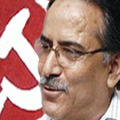
The former Himalayan Kingdom, now a republic, Nepal waits for its first President. The proposed 'Head of the State', who will replace the King, is supposed to get elected today (Saturday). After days of failed discussions among the major political parties for a consensus on the ceremonial post, they have decided to go for polls in the Constituent Assembly to choose the first democratically elected President of Nepal.
After a decade of armed movement by the Nepali communist (Maoist) rebels for ending the monarchy, the country went for a general election in April 2008 and a Constituent Assembly was formed. In the 601-member Nepal constituent assembly polls, the Communist Party of Nepal (Maoist) won in 220 constituencies. The other left party named Communist Party of Nepal-United-Marxist-Leninist (CPN-UML) succeeded in 103 constitutions. The major political party Nepali Congress won 110 seats.
Initially the Communist Party of Nepal (Maoist), which led the bloody revolution that killed more than 10,000 people, demanded both the posts of President and Prime Minister in the coalition government. Surfaced as a new power in Nepali politics, the Maoist chairman Pushpa Kamal Dahal, more popularly known as Prachanda, made it clear that they must be allowed to form the government with both the top posts in their net.
Prachanda, during an interview on May 30, stated, "Our Party deserves both the posts of President and Prime Minister. Losers (read Nepali Congress and CPN-UML) in the Constituent Assembly polls cannot get these posts."
But the other political parties were not in the mood to buy the theory. The Nepali Congress leaders argued, being the largest political party, the CPN-M has the legitimate claim to form the next government, but they should share one post to other coalition partners. Facing the heat, the Maoist leaders retreated and spared the post of President.
Initially, the veteran Nepali politician Girija Prasad Koirala also came out as a probable candidate for the post. However his candidature was out rightly opposed by Prachanda opposed the Nepali Congress leader for the assignment due to his age and health. Prachanda commented officially that they wouldn't accept Koirala because of his age and fragile health.
Terming Koirala as a Grand National figure, Prachanda added, "More over, he has been in power for long and if he is given the post (president) there is a possibility of two power centres in the government."
Koirala, 83, is still acting as the Prime Minister of Nepal and waiting to submit his resignation letter to the new President. After his resignation, Prachanda is expected to form the government and becomes the Prime Minister of Nepal with executive power.
Now the Maoist has backed the candidature of Ram Raja Prasad Singh, 74 for the post. The Nepali Congress, the second largest party after CPN-M, has fielded Ram Baran Yadav, 61 and the third major party UML has gone with Ram Preet Paswan, 55.
In the polls, a candidate has to receive 301 votes to win. As the Maoists contain 226 members and few other Madhesi parties (with 82 members) are supporting Ram Raja Prasad Singh, who holds a Master's degree (Law) from Delhi University, enjoys the edge.
"What is significant that the first president of Nepal is supposed to get elected from some one originated in India. One can says the hilly Nepal will get the President not from the Pahari (hill people) communities. As all the three major political parties have fielded candidates from Madhesi communities from the southern Terai region, which belongs to Indian origin people, we can assume it definitely," commented a Nepali political observer based in Kathmandu.
Mentionable that the representatives of the Madhesi community remained vocal for their various demands expecting a share in Nepal politics. They continued their agitation in the Assembly for many days, which prevented the functioning of the house. They are primarily demanding an autonomous status in southern Nepal. The Madhesi community has 81 elected members in the 601-member Constituent Assembly and possesses nearly 50% population of Nepal (total 27 million).
Nava Thakuria
The author is a Guwahati based journalist and he contributes articles for a number of newspapers and portals based in different parts of the globe. His special focus areas remain the socio-political developments in Northeast and India as a whole. He can be reached at navathakuria@gmail.com
|
|


Comments: